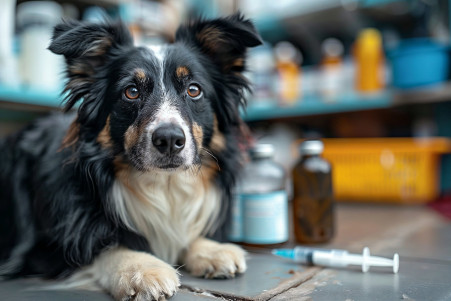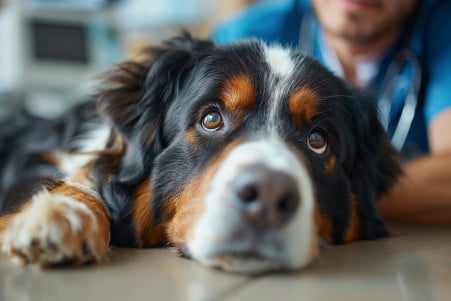Can Cats Get Parvovirus From Dogs? Exploring the Risks
4 May 2024 • Updated 3 May 2024

Many cat owners have wondered if their pets can get parvovirus from dogs, and it's a question that has implications for everything from how viruses are transmitted between species to how pet owners can protect their animals. The simple answer is no - the feline and canine versions of parvovirus are different viruses that only affect their respective species and can't be transmitted between cats and dogs.
However, a closer look at the complex world of feline and canine viruses reveals important details. In this article, we'll take a deep dive into the most recent veterinary science to explore the characteristics, transmission, and potential risks of these viruses. By the end of this journey, you'll have a solid understanding of the topic that will help you keep your pets safe and healthy, whether you have one pet or many.
Can cats get parvovirus from dogs?
Feline Panleukopenia Virus (FPV): Symptoms and Treatment
Feline panleukopenia virus (FPV), also known as feline distemper or feline parvovirus, is a highly contagious and potentially fatal viral disease affecting cats. Clinical signs of the disease include vomiting, watery diarrhea (which may be bloody), fever, lethargy, anorexia, and severe dehydration, according to the Merck Veterinary Manual.
Kittens under 5 months old are at the highest risk of severe illness and death from FPV due to their immature immune systems. As noted in Cats Protection's guidance, kittens may have some protection from a vaccinated mother, but this immunity is short-lived, emphasizing the importance of timely kitten vaccination.
Unfortunately, there is no specific treatment for FPV. Veterinary care is supportive and includes fluid therapy to correct dehydration, nutritional support, and antibiotics to treat secondary bacterial infections, according to the Merck Veterinary Manual. Cats with severe disease may need to be hospitalized for supportive care to treat shock and other life-threatening complications of the viral infection.
Although it is different from the canine parvovirus that affects dogs, the feline panleukopenia virus is a serious concern for cats, especially kittens, and requires careful monitoring and immediate veterinary care. This sets the stage for our next look at the dangers and consequences of canine parvovirus in dogs.
Canine Parvovirus (CPV): A Danger to Puppies and Dogs Who Aren't Vaccinated
Canine parvovirus (CPV) is a highly contagious and potentially fatal viral disease that primarily affects puppies and unvaccinated dogs, according to the American Veterinary Medical Association. CPV is transmitted through direct contact with infected dogs or their feces, as well as through contaminated objects and environments. The virus causes severe vomiting, diarrhea, loss of appetite, and lethargy, and can result in dehydration and secondary infections, which can be life-threatening if not treated, according to All Creatures Animal Hospital.
Treatment for CPV is supportive and includes fluid therapy, anti-nausea drugs, and antibiotics to prevent or treat secondary infections, according to the Humane Pro article. The best way to prevent CPV is through vaccination, and it's important to make sure that puppies and unvaccinated adult dogs are vaccinated according to the recommended schedule.
Because CPV is so contagious and can live in the environment for long periods of time, it's important to follow strict disinfection and isolation procedures to prevent and control the spread of the virus, according to the American Veterinary Medical Association.
Environmental Persistence and Disinfection: How Parvovirus Is Controlled
Parvovirus is known for its environmental stability, and it can live for months or even years in the environment depending on the circumstances. As noted by the Cornell University College of Veterinary Medicine, infected animals can shed large amounts of the virus, which can make it hard to effectively disinfect an area after it has been contaminated.
Disinfection is especially important when it comes to parvovirus because it is resistant to many common household cleaners. The Spruce Pets explains that a 1:30 solution of bleach to water is effective, but it should be rinsed off after being left on the surface for 10-15 minutes. Other effective disinfectants include accelerated hydrogen peroxide and potassium peroxymonosulfate products.
Cleaning and disinfecting indoor and outdoor environments, as well as disposing of or cleaning contaminated items, are all important parts of controlling parvovirus. As noted by Whole Dog Journal, this includes cleaning up feces, using bleach solutions, and using heavy-duty detergents and disinfectants with at least a 10-minute contact time. Doing these things can help reduce the environmental persistence of parvovirus and prevent it from being transmitted between animals.
How to Stop the Spread of Parvovirus: Vaccination and Hygiene
Vaccination is the most important way to stop the spread of parvovirus in both cats and dogs. The American Veterinary Medical Association notes that kittens and puppies should be vaccinated according to the recommended schedule and receive booster shots as directed by their vets.
In addition, good hygiene, including regular cleaning and disinfecting of living spaces, and avoiding contact with infected animals or their feces can help lower the risk of transmission, according to the Mission Veterinary Hospital. It’s also important to quarantine new animals, especially those with unknown vaccination status, before introducing them to other pets, according to The Dodo.
Getting medical attention for animals as soon as they show signs of illness and following isolation guidelines can help prevent the spread of the virus. Pet owners can take these steps to protect their cats and dogs from the potentially deadly virus.
Conclusion: How to Keep a Safe and Healthy Multi-Pet Household
Although the chances of direct transmission of parvovirus between cats and dogs are very low, the potential risks are still there, especially for people with multiple pets. As Clorox® notes, a solution of 1/2 cup Clorox® Disinfecting Bleach and one gallon of water can kill canine parvovirus on hard, non-porous surfaces if left on for 10 minutes.
Responsible pet ownership practices, including vaccination, hygiene, and prompt veterinary care, are important for preventing and controlling parvovirus outbreaks. As Catster points out, while cats can carry and shed certain variants of the dog parvovirus, it is not commonly a cause of disease in cats. However, as Ark Vets observes, cats can get parvovirus from dogs through direct contact or exposure to contaminated environments.
Understanding the environmental persistence of parvovirus and the proper ways to disinfect can help reduce the spread of the virus and protect both dogs and cats. Meanwhile, knowing the differences between feline and canine parvovirus strains can help pet owners make informed choices and take the right steps to ensure their pets are safe and healthy. Working with a veterinarian and keeping up with the latest research and guidelines is important for protecting the health of pets in multi-species households.


